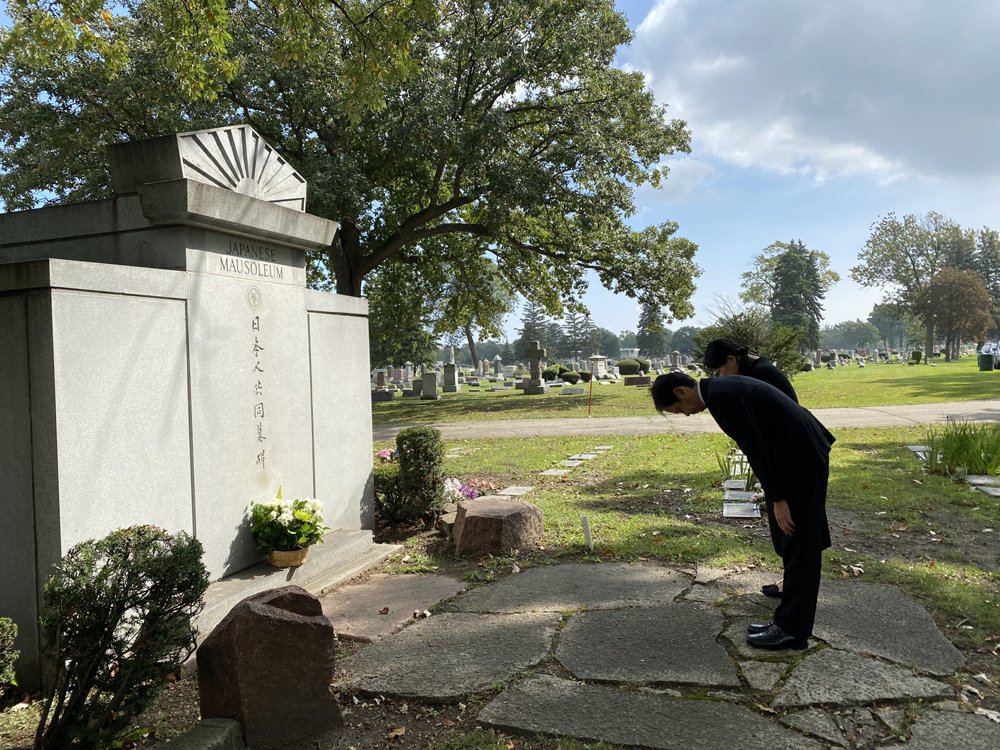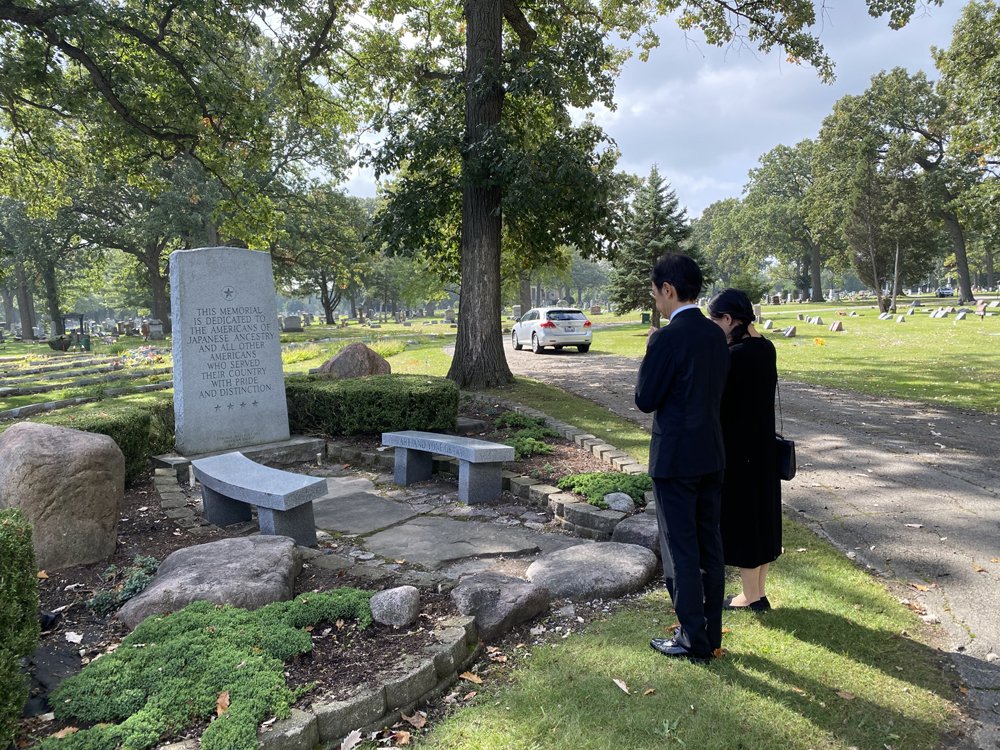Tribute to Japanese Ancestors, New Consul General Yanagi at Montrose Cemetery
Consul General Jun Yanagi and his wife Norika pose for a photo with board members of the Japanese Mutual Aid Society of Chicago in front of the Japanese Mausoleum on September 29, 2023.
Consul General Jun Yanagi and his wife Norika visited the Montrose Cemetery on September 29 to pay floral tribute to the ancestors who had pioneered to establishment of the Japanese-American community in the Chicago area.
The Montrose Cemetery on the north side of Chicago was only the cemetery that accepted burials of Japanese people amid a difficult time of severe racial discrimination in the 1900s. Japanese pioneers used to say, “We have nowhere to go after our death.”
Karen Kanemoto, Executive Director of the Japanese Mutual Aid Society of Chicago, welcomed the Consul General and his wife to the cemetery and explained how the Japanese section of the cemetery had been developed. Other board members of the Society also attended the Consul General’s visit and talked about brief family history and activities. They were Gary Shimomura, President; Bryan Funai, Secretary; Mary Samson, Treasurer; Neil Kanemoto, Director; Gwen Kato, Director; and Pam Morooka, Director. Commander Robert Hashimoto of the Chicago Nisei Post 1183 and Consul Sanae Kanno from the Consulate General of Japan in Chicago also attended.
The group walked around the Japanese section of Cherry Triangle, Cherry Triangle Annex, and Oakhill Annex, and C.G. Yanagi and his wife offered flowers at the Japanese Mausoleum where remains of ancestors with no relatives were put in storage. The couple also paid tribute to Nisei soldiers who fought in the 100th Infantry Battalion, the 442nd Regimental Combat Team, and the U.S. Military Intelligence Service for their own country. The 100th and the 442nd are known as the most decollated units in the U.S.
C.G. Yanagi said after his visit, “Standing by this historical cemetery makes me imagine the lives of ancestors who overcame many hardships and devoted themselves to making a better community for their descendants, and it was a very quiet moment to express my deep gratitude to the ancestors. I also had a very good time learning about each Society member’s story about the history of the Japanese-American community during a luncheon. It was my precious time.”
History of Montrose Cemetery and Japanese Community
After The World's Columbian Exposition of 1893, a small number of Japanese people began to live in Chicago. The number gradually increased by about 300 when the Chicago World's Fair of 1933 was held, and most of them were restaurant workers, domestics, and small gift shop owners.
Japanese laborers, who worked in restaurants as cooks or washers, were mostly singles and apt to die without relatives or money. The Japanese community in Chicago concerned about those workers dying alone and began to discuss fundraising to pay for their final expenses and dignified burials.
In December 1934, the Japanese community leaders had a meeting to set up an official organization, and research held by one of the leaders found that 50 people died during the past 15 years, and about 40 of them were without relatives or funds. The Japanese community had to assist with their final expenses and burials.
The group of leaders decided to call for all the community members to become paid members of the new organization, the Japanese Mutual Aid Society of Chicago.
The Japanese Mutual Aid of Society officially started in January 1935, and its board members were elected. The Society purchased four cemetery lots in the Montrose Cemetery and began to build a Japanese Mausoleum in the cemetery in 1936 to keep the remains of the people who had died alone. The Mausoleum was completed in the same year and the unveiling ceremony was held on Memorial Day in 1938. Since then, the Society has hosted annual community Memorial Day Services to the present day.
During and after WWII, about 20,000 Japanese Americans, who were incarcerated in concentration camps across the U.S., moved into Chicago, and the Society prepared a hostel to accommodate newcomers until they found their permanent housing. As the Japanese-American population rose, the membership of the Society increased. At the same time, the Society faced a need for more grave plots.
The Society board decided to implement fundraising with a goal of $3,500 and send out only one appeal letter to the members. There was no individual solicitation. As a result, the Society saw donations of $5,416 in response to the single appeal letter. With the amount of donations, the Society was able to purchase 350 plots in the Montrose Cemetery. Indeed the officials in the Cemetery were deeply impressed by the strong solidarity of the Japanese community.
For more information about the Japanese Mutual Aid Society of Chicago, visit https://jmaschicago.org.
About Montrose Cemetery
The Montrose Cemetery, founded by Andrew Kircher in 1902, has been owned and operated by the founder’s descendants.
According to the Cemetery’s website, founder Kircher may have been of German heritage, but he always embraced a diverse clientele and adhered to a policy of “Everyone is Welcome.”
The website reads as follows:
“Today, that philosophy is still practiced and can be seen throughout the cemetery. Montrose remains a non-sectarian Cemetery. Among some of the cultures represented with us are Japanese, German, Assyrian, Serbian, Korean, Russian, Hispanic, Muslim and many more.”
For more information about the Montrose Cemetery, visit https://www.montrosecemetery.com.
Montrose Cemetery on Memorial Day in 2018




